Financial Accounting Report on Corporate Social Responsibility
VerifiedAdded on 2023/04/21
|10
|3078
|82
Report
AI Summary
This report analyzes financial accounting and corporate social responsibility, with a focus on the Adani Mining Group. Part A addresses research questions on topics such as the Carbon Disclosure Project, legitimacy theory, IPCC, Cap and Trade policy, motivational factors for managers, full cost accounting, stakeholder expectations, climate change reporting, and Puma's Environmental Profit and Loss report. Part B delves into the Adani project, examining revenue streams for the State and Federal Government, the Australian government's decision on native title, the allowance for dumping on the Great Barrier Reef, and the project's impact on carbon emissions, Aboriginal people, and water pollution. The report highlights the complex interplay between financial considerations, environmental impact, and stakeholder interests, presenting a comprehensive overview of the Adani project within the context of corporate social responsibility.
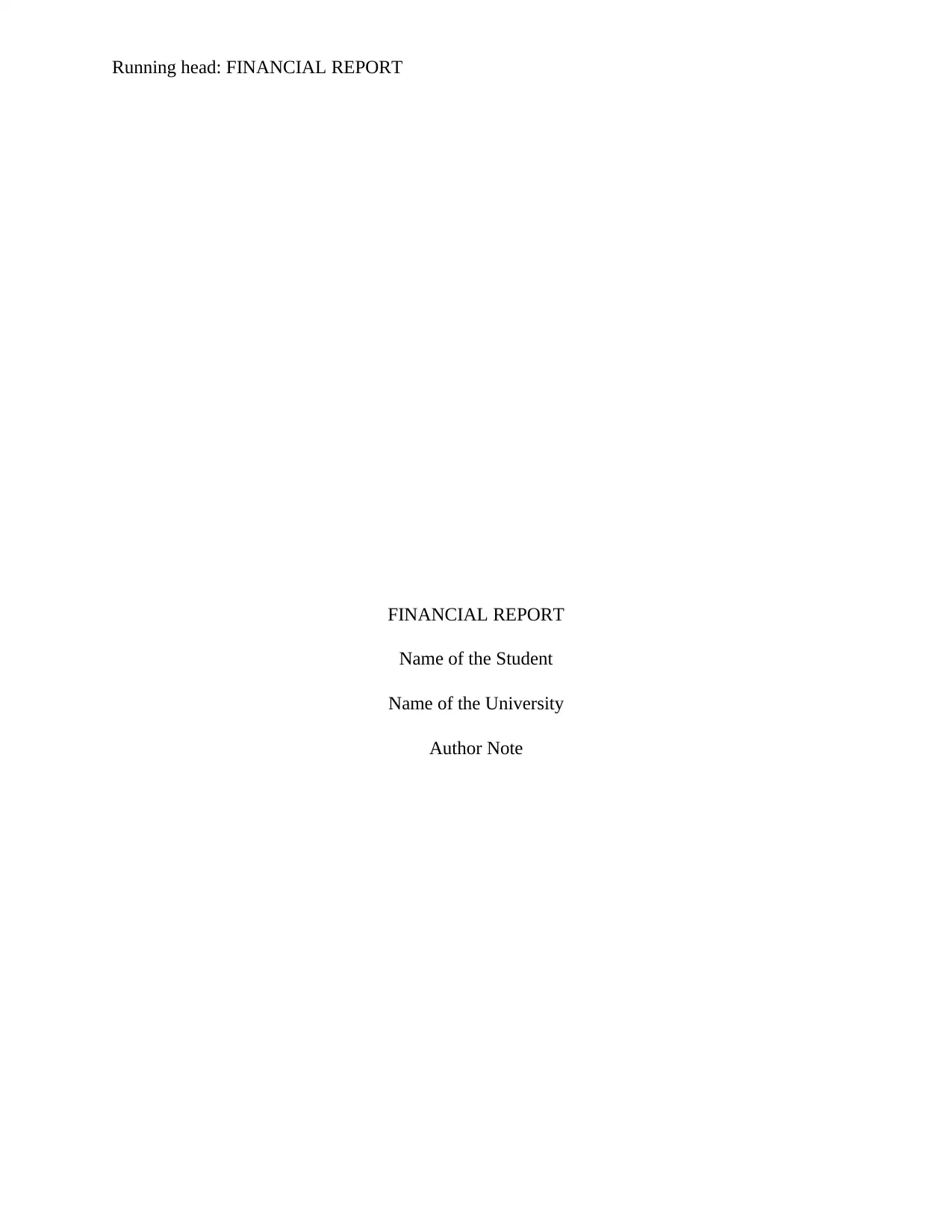
Running head: FINANCIAL REPORT
FINANCIAL REPORT
Name of the Student
Name of the University
Author Note
FINANCIAL REPORT
Name of the Student
Name of the University
Author Note
Paraphrase This Document
Need a fresh take? Get an instant paraphrase of this document with our AI Paraphraser
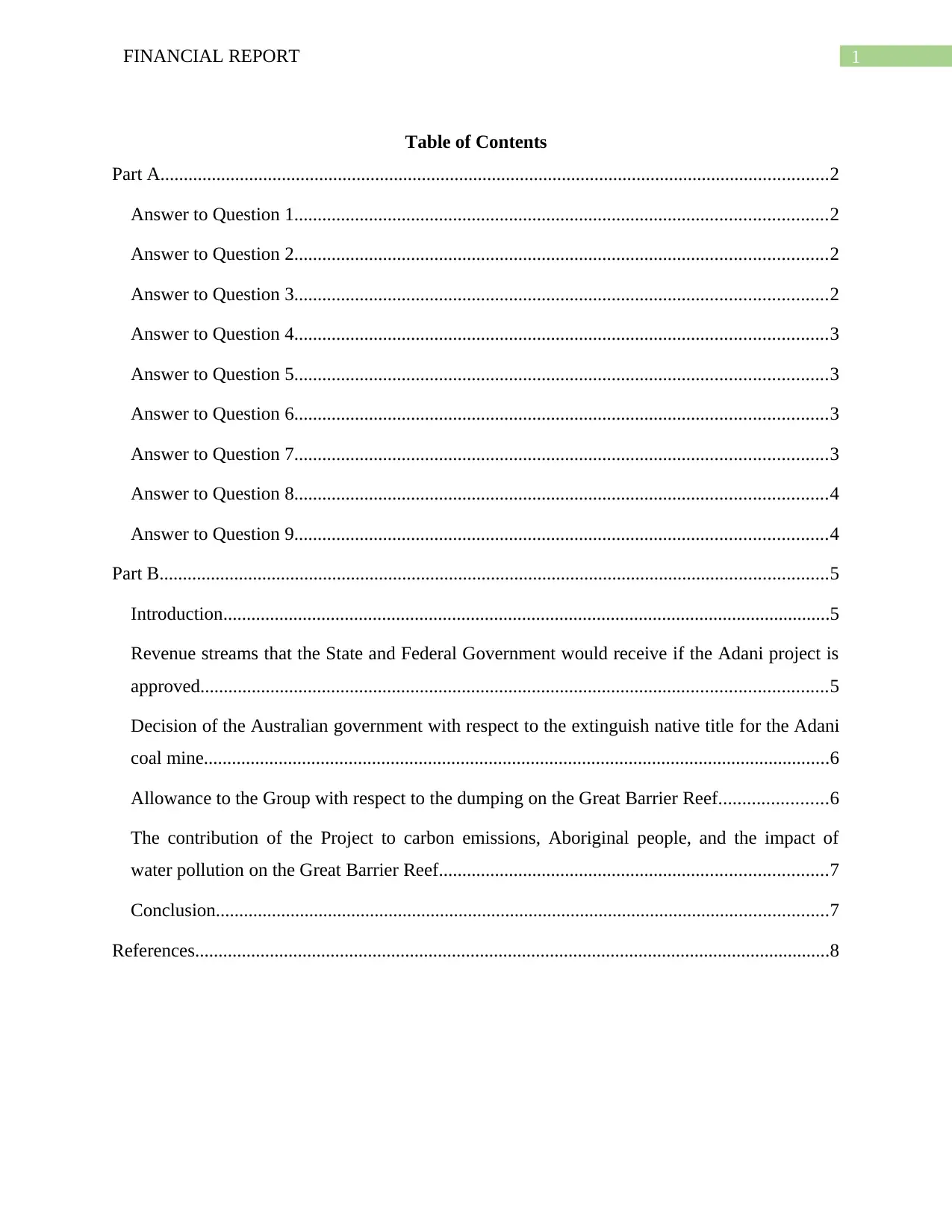
1FINANCIAL REPORT
Table of Contents
Part A...............................................................................................................................................2
Answer to Question 1..................................................................................................................2
Answer to Question 2..................................................................................................................2
Answer to Question 3..................................................................................................................2
Answer to Question 4..................................................................................................................3
Answer to Question 5..................................................................................................................3
Answer to Question 6..................................................................................................................3
Answer to Question 7..................................................................................................................3
Answer to Question 8..................................................................................................................4
Answer to Question 9..................................................................................................................4
Part B...............................................................................................................................................5
Introduction..................................................................................................................................5
Revenue streams that the State and Federal Government would receive if the Adani project is
approved......................................................................................................................................5
Decision of the Australian government with respect to the extinguish native title for the Adani
coal mine......................................................................................................................................6
Allowance to the Group with respect to the dumping on the Great Barrier Reef.......................6
The contribution of the Project to carbon emissions, Aboriginal people, and the impact of
water pollution on the Great Barrier Reef...................................................................................7
Conclusion...................................................................................................................................7
References........................................................................................................................................8
Table of Contents
Part A...............................................................................................................................................2
Answer to Question 1..................................................................................................................2
Answer to Question 2..................................................................................................................2
Answer to Question 3..................................................................................................................2
Answer to Question 4..................................................................................................................3
Answer to Question 5..................................................................................................................3
Answer to Question 6..................................................................................................................3
Answer to Question 7..................................................................................................................3
Answer to Question 8..................................................................................................................4
Answer to Question 9..................................................................................................................4
Part B...............................................................................................................................................5
Introduction..................................................................................................................................5
Revenue streams that the State and Federal Government would receive if the Adani project is
approved......................................................................................................................................5
Decision of the Australian government with respect to the extinguish native title for the Adani
coal mine......................................................................................................................................6
Allowance to the Group with respect to the dumping on the Great Barrier Reef.......................6
The contribution of the Project to carbon emissions, Aboriginal people, and the impact of
water pollution on the Great Barrier Reef...................................................................................7
Conclusion...................................................................................................................................7
References........................................................................................................................................8
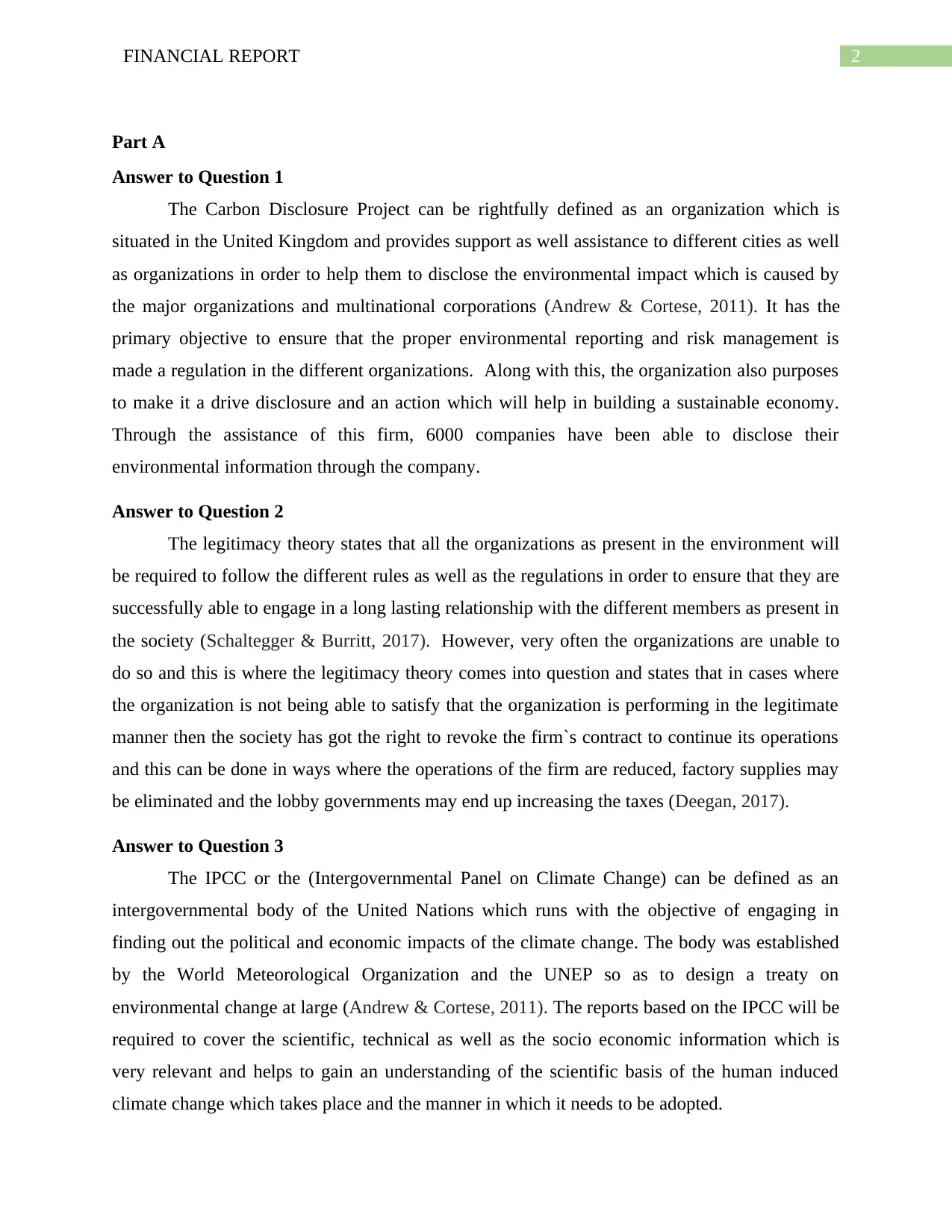
2FINANCIAL REPORT
Part A
Answer to Question 1
The Carbon Disclosure Project can be rightfully defined as an organization which is
situated in the United Kingdom and provides support as well assistance to different cities as well
as organizations in order to help them to disclose the environmental impact which is caused by
the major organizations and multinational corporations (Andrew & Cortese, 2011). It has the
primary objective to ensure that the proper environmental reporting and risk management is
made a regulation in the different organizations. Along with this, the organization also purposes
to make it a drive disclosure and an action which will help in building a sustainable economy.
Through the assistance of this firm, 6000 companies have been able to disclose their
environmental information through the company.
Answer to Question 2
The legitimacy theory states that all the organizations as present in the environment will
be required to follow the different rules as well as the regulations in order to ensure that they are
successfully able to engage in a long lasting relationship with the different members as present in
the society (Schaltegger & Burritt, 2017). However, very often the organizations are unable to
do so and this is where the legitimacy theory comes into question and states that in cases where
the organization is not being able to satisfy that the organization is performing in the legitimate
manner then the society has got the right to revoke the firm`s contract to continue its operations
and this can be done in ways where the operations of the firm are reduced, factory supplies may
be eliminated and the lobby governments may end up increasing the taxes (Deegan, 2017).
Answer to Question 3
The IPCC or the (Intergovernmental Panel on Climate Change) can be defined as an
intergovernmental body of the United Nations which runs with the objective of engaging in
finding out the political and economic impacts of the climate change. The body was established
by the World Meteorological Organization and the UNEP so as to design a treaty on
environmental change at large (Andrew & Cortese, 2011). The reports based on the IPCC will be
required to cover the scientific, technical as well as the socio economic information which is
very relevant and helps to gain an understanding of the scientific basis of the human induced
climate change which takes place and the manner in which it needs to be adopted.
Part A
Answer to Question 1
The Carbon Disclosure Project can be rightfully defined as an organization which is
situated in the United Kingdom and provides support as well assistance to different cities as well
as organizations in order to help them to disclose the environmental impact which is caused by
the major organizations and multinational corporations (Andrew & Cortese, 2011). It has the
primary objective to ensure that the proper environmental reporting and risk management is
made a regulation in the different organizations. Along with this, the organization also purposes
to make it a drive disclosure and an action which will help in building a sustainable economy.
Through the assistance of this firm, 6000 companies have been able to disclose their
environmental information through the company.
Answer to Question 2
The legitimacy theory states that all the organizations as present in the environment will
be required to follow the different rules as well as the regulations in order to ensure that they are
successfully able to engage in a long lasting relationship with the different members as present in
the society (Schaltegger & Burritt, 2017). However, very often the organizations are unable to
do so and this is where the legitimacy theory comes into question and states that in cases where
the organization is not being able to satisfy that the organization is performing in the legitimate
manner then the society has got the right to revoke the firm`s contract to continue its operations
and this can be done in ways where the operations of the firm are reduced, factory supplies may
be eliminated and the lobby governments may end up increasing the taxes (Deegan, 2017).
Answer to Question 3
The IPCC or the (Intergovernmental Panel on Climate Change) can be defined as an
intergovernmental body of the United Nations which runs with the objective of engaging in
finding out the political and economic impacts of the climate change. The body was established
by the World Meteorological Organization and the UNEP so as to design a treaty on
environmental change at large (Andrew & Cortese, 2011). The reports based on the IPCC will be
required to cover the scientific, technical as well as the socio economic information which is
very relevant and helps to gain an understanding of the scientific basis of the human induced
climate change which takes place and the manner in which it needs to be adopted.
⊘ This is a preview!⊘
Do you want full access?
Subscribe today to unlock all pages.

Trusted by 1+ million students worldwide
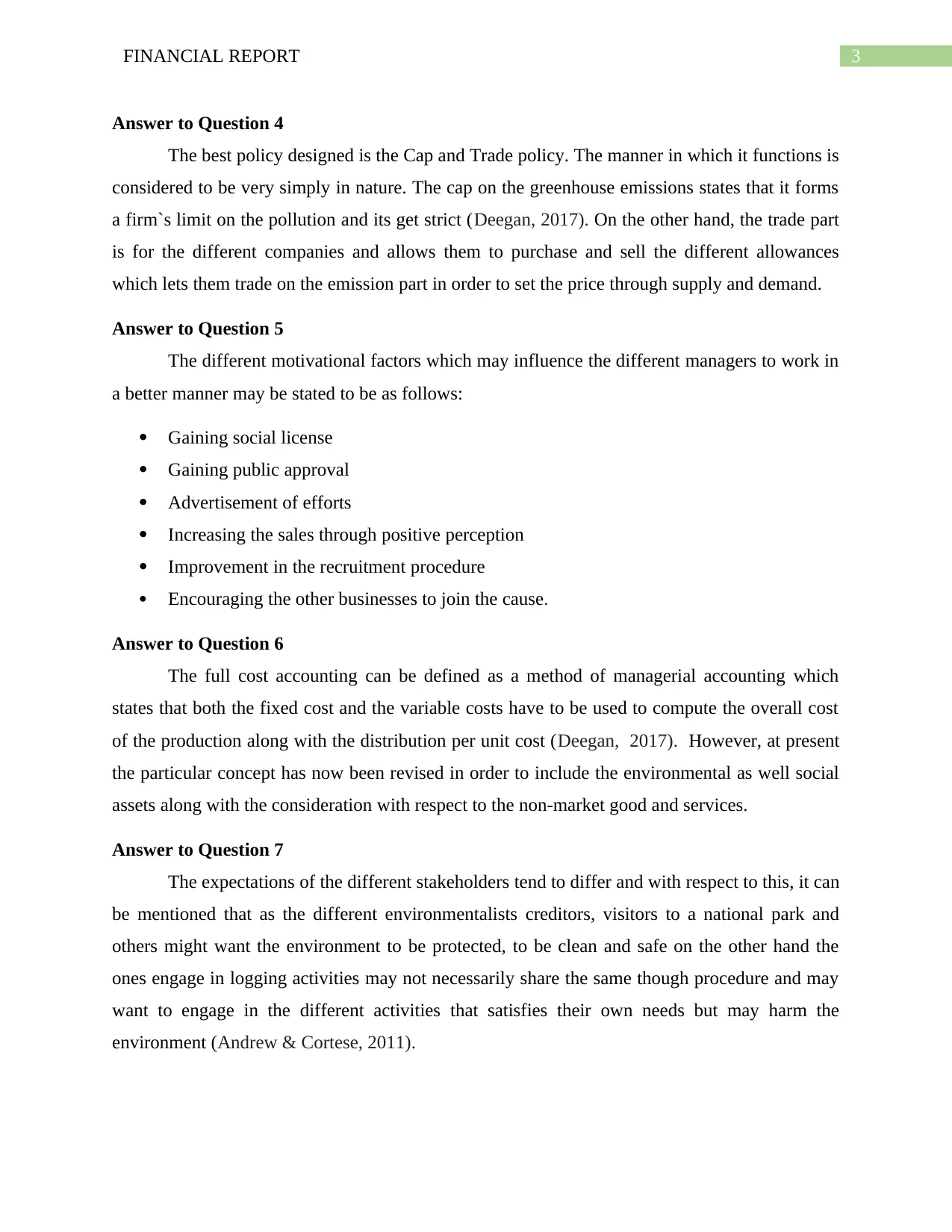
3FINANCIAL REPORT
Answer to Question 4
The best policy designed is the Cap and Trade policy. The manner in which it functions is
considered to be very simply in nature. The cap on the greenhouse emissions states that it forms
a firm`s limit on the pollution and its get strict (Deegan, 2017). On the other hand, the trade part
is for the different companies and allows them to purchase and sell the different allowances
which lets them trade on the emission part in order to set the price through supply and demand.
Answer to Question 5
The different motivational factors which may influence the different managers to work in
a better manner may be stated to be as follows:
Gaining social license
Gaining public approval
Advertisement of efforts
Increasing the sales through positive perception
Improvement in the recruitment procedure
Encouraging the other businesses to join the cause.
Answer to Question 6
The full cost accounting can be defined as a method of managerial accounting which
states that both the fixed cost and the variable costs have to be used to compute the overall cost
of the production along with the distribution per unit cost (Deegan, 2017). However, at present
the particular concept has now been revised in order to include the environmental as well social
assets along with the consideration with respect to the non-market good and services.
Answer to Question 7
The expectations of the different stakeholders tend to differ and with respect to this, it can
be mentioned that as the different environmentalists creditors, visitors to a national park and
others might want the environment to be protected, to be clean and safe on the other hand the
ones engage in logging activities may not necessarily share the same though procedure and may
want to engage in the different activities that satisfies their own needs but may harm the
environment (Andrew & Cortese, 2011).
Answer to Question 4
The best policy designed is the Cap and Trade policy. The manner in which it functions is
considered to be very simply in nature. The cap on the greenhouse emissions states that it forms
a firm`s limit on the pollution and its get strict (Deegan, 2017). On the other hand, the trade part
is for the different companies and allows them to purchase and sell the different allowances
which lets them trade on the emission part in order to set the price through supply and demand.
Answer to Question 5
The different motivational factors which may influence the different managers to work in
a better manner may be stated to be as follows:
Gaining social license
Gaining public approval
Advertisement of efforts
Increasing the sales through positive perception
Improvement in the recruitment procedure
Encouraging the other businesses to join the cause.
Answer to Question 6
The full cost accounting can be defined as a method of managerial accounting which
states that both the fixed cost and the variable costs have to be used to compute the overall cost
of the production along with the distribution per unit cost (Deegan, 2017). However, at present
the particular concept has now been revised in order to include the environmental as well social
assets along with the consideration with respect to the non-market good and services.
Answer to Question 7
The expectations of the different stakeholders tend to differ and with respect to this, it can
be mentioned that as the different environmentalists creditors, visitors to a national park and
others might want the environment to be protected, to be clean and safe on the other hand the
ones engage in logging activities may not necessarily share the same though procedure and may
want to engage in the different activities that satisfies their own needs but may harm the
environment (Andrew & Cortese, 2011).
Paraphrase This Document
Need a fresh take? Get an instant paraphrase of this document with our AI Paraphraser
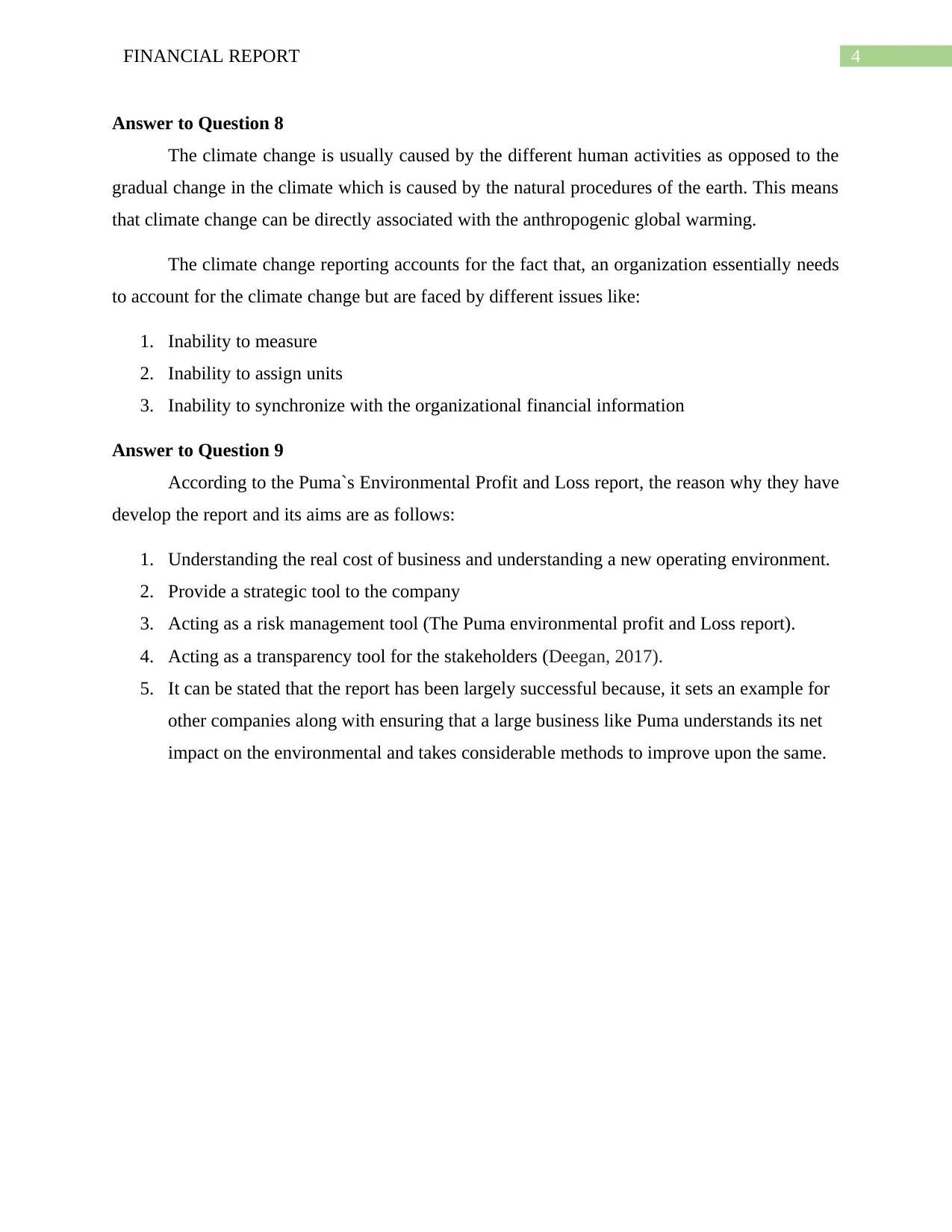
4FINANCIAL REPORT
Answer to Question 8
The climate change is usually caused by the different human activities as opposed to the
gradual change in the climate which is caused by the natural procedures of the earth. This means
that climate change can be directly associated with the anthropogenic global warming.
The climate change reporting accounts for the fact that, an organization essentially needs
to account for the climate change but are faced by different issues like:
1. Inability to measure
2. Inability to assign units
3. Inability to synchronize with the organizational financial information
Answer to Question 9
According to the Puma`s Environmental Profit and Loss report, the reason why they have
develop the report and its aims are as follows:
1. Understanding the real cost of business and understanding a new operating environment.
2. Provide a strategic tool to the company
3. Acting as a risk management tool (The Puma environmental profit and Loss report).
4. Acting as a transparency tool for the stakeholders (Deegan, 2017).
5. It can be stated that the report has been largely successful because, it sets an example for
other companies along with ensuring that a large business like Puma understands its net
impact on the environmental and takes considerable methods to improve upon the same.
Answer to Question 8
The climate change is usually caused by the different human activities as opposed to the
gradual change in the climate which is caused by the natural procedures of the earth. This means
that climate change can be directly associated with the anthropogenic global warming.
The climate change reporting accounts for the fact that, an organization essentially needs
to account for the climate change but are faced by different issues like:
1. Inability to measure
2. Inability to assign units
3. Inability to synchronize with the organizational financial information
Answer to Question 9
According to the Puma`s Environmental Profit and Loss report, the reason why they have
develop the report and its aims are as follows:
1. Understanding the real cost of business and understanding a new operating environment.
2. Provide a strategic tool to the company
3. Acting as a risk management tool (The Puma environmental profit and Loss report).
4. Acting as a transparency tool for the stakeholders (Deegan, 2017).
5. It can be stated that the report has been largely successful because, it sets an example for
other companies along with ensuring that a large business like Puma understands its net
impact on the environmental and takes considerable methods to improve upon the same.
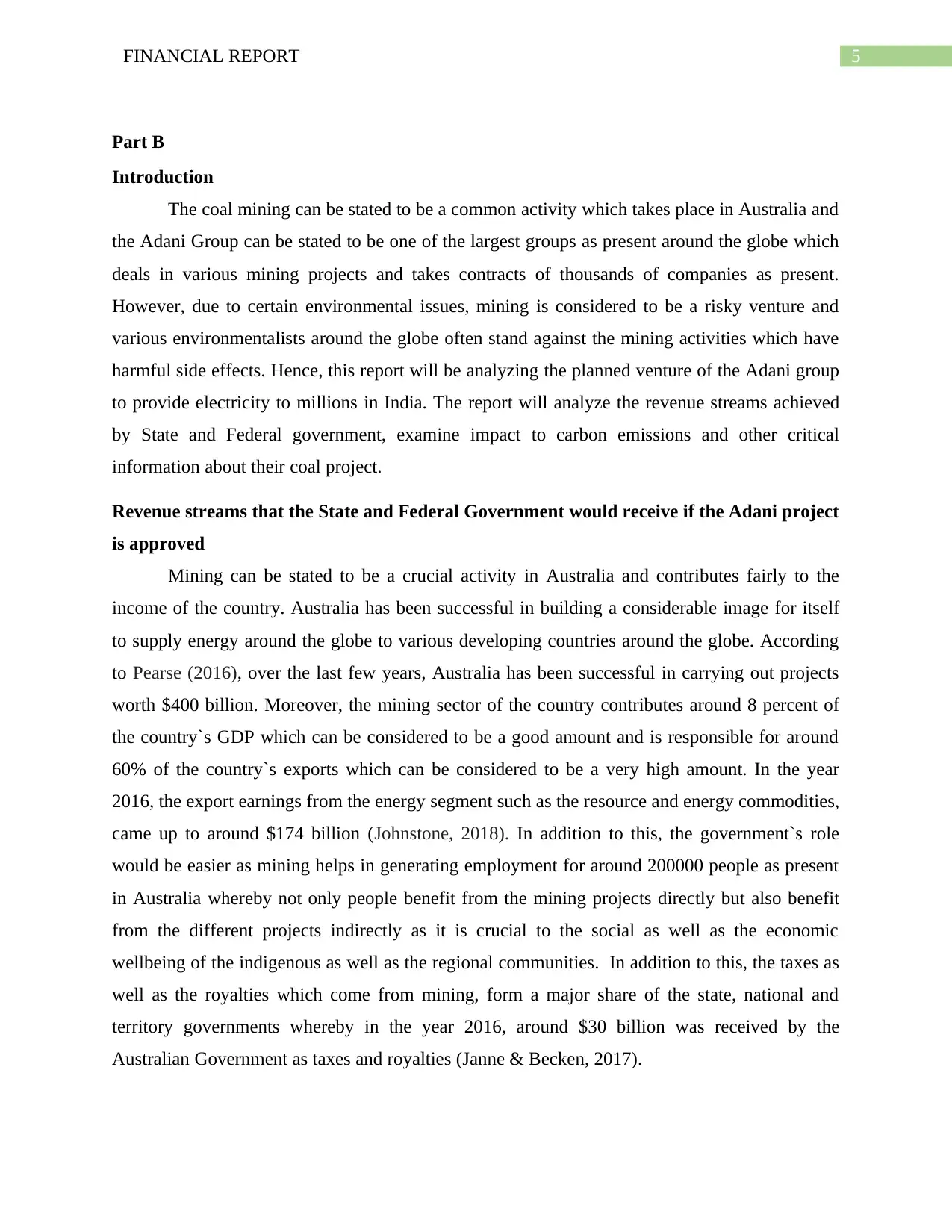
5FINANCIAL REPORT
Part B
Introduction
The coal mining can be stated to be a common activity which takes place in Australia and
the Adani Group can be stated to be one of the largest groups as present around the globe which
deals in various mining projects and takes contracts of thousands of companies as present.
However, due to certain environmental issues, mining is considered to be a risky venture and
various environmentalists around the globe often stand against the mining activities which have
harmful side effects. Hence, this report will be analyzing the planned venture of the Adani group
to provide electricity to millions in India. The report will analyze the revenue streams achieved
by State and Federal government, examine impact to carbon emissions and other critical
information about their coal project.
Revenue streams that the State and Federal Government would receive if the Adani project
is approved
Mining can be stated to be a crucial activity in Australia and contributes fairly to the
income of the country. Australia has been successful in building a considerable image for itself
to supply energy around the globe to various developing countries around the globe. According
to Pearse (2016), over the last few years, Australia has been successful in carrying out projects
worth $400 billion. Moreover, the mining sector of the country contributes around 8 percent of
the country`s GDP which can be considered to be a good amount and is responsible for around
60% of the country`s exports which can be considered to be a very high amount. In the year
2016, the export earnings from the energy segment such as the resource and energy commodities,
came up to around $174 billion (Johnstone, 2018). In addition to this, the government`s role
would be easier as mining helps in generating employment for around 200000 people as present
in Australia whereby not only people benefit from the mining projects directly but also benefit
from the different projects indirectly as it is crucial to the social as well as the economic
wellbeing of the indigenous as well as the regional communities. In addition to this, the taxes as
well as the royalties which come from mining, form a major share of the state, national and
territory governments whereby in the year 2016, around $30 billion was received by the
Australian Government as taxes and royalties (Janne & Becken, 2017).
Part B
Introduction
The coal mining can be stated to be a common activity which takes place in Australia and
the Adani Group can be stated to be one of the largest groups as present around the globe which
deals in various mining projects and takes contracts of thousands of companies as present.
However, due to certain environmental issues, mining is considered to be a risky venture and
various environmentalists around the globe often stand against the mining activities which have
harmful side effects. Hence, this report will be analyzing the planned venture of the Adani group
to provide electricity to millions in India. The report will analyze the revenue streams achieved
by State and Federal government, examine impact to carbon emissions and other critical
information about their coal project.
Revenue streams that the State and Federal Government would receive if the Adani project
is approved
Mining can be stated to be a crucial activity in Australia and contributes fairly to the
income of the country. Australia has been successful in building a considerable image for itself
to supply energy around the globe to various developing countries around the globe. According
to Pearse (2016), over the last few years, Australia has been successful in carrying out projects
worth $400 billion. Moreover, the mining sector of the country contributes around 8 percent of
the country`s GDP which can be considered to be a good amount and is responsible for around
60% of the country`s exports which can be considered to be a very high amount. In the year
2016, the export earnings from the energy segment such as the resource and energy commodities,
came up to around $174 billion (Johnstone, 2018). In addition to this, the government`s role
would be easier as mining helps in generating employment for around 200000 people as present
in Australia whereby not only people benefit from the mining projects directly but also benefit
from the different projects indirectly as it is crucial to the social as well as the economic
wellbeing of the indigenous as well as the regional communities. In addition to this, the taxes as
well as the royalties which come from mining, form a major share of the state, national and
territory governments whereby in the year 2016, around $30 billion was received by the
Australian Government as taxes and royalties (Janne & Becken, 2017).
⊘ This is a preview!⊘
Do you want full access?
Subscribe today to unlock all pages.

Trusted by 1+ million students worldwide
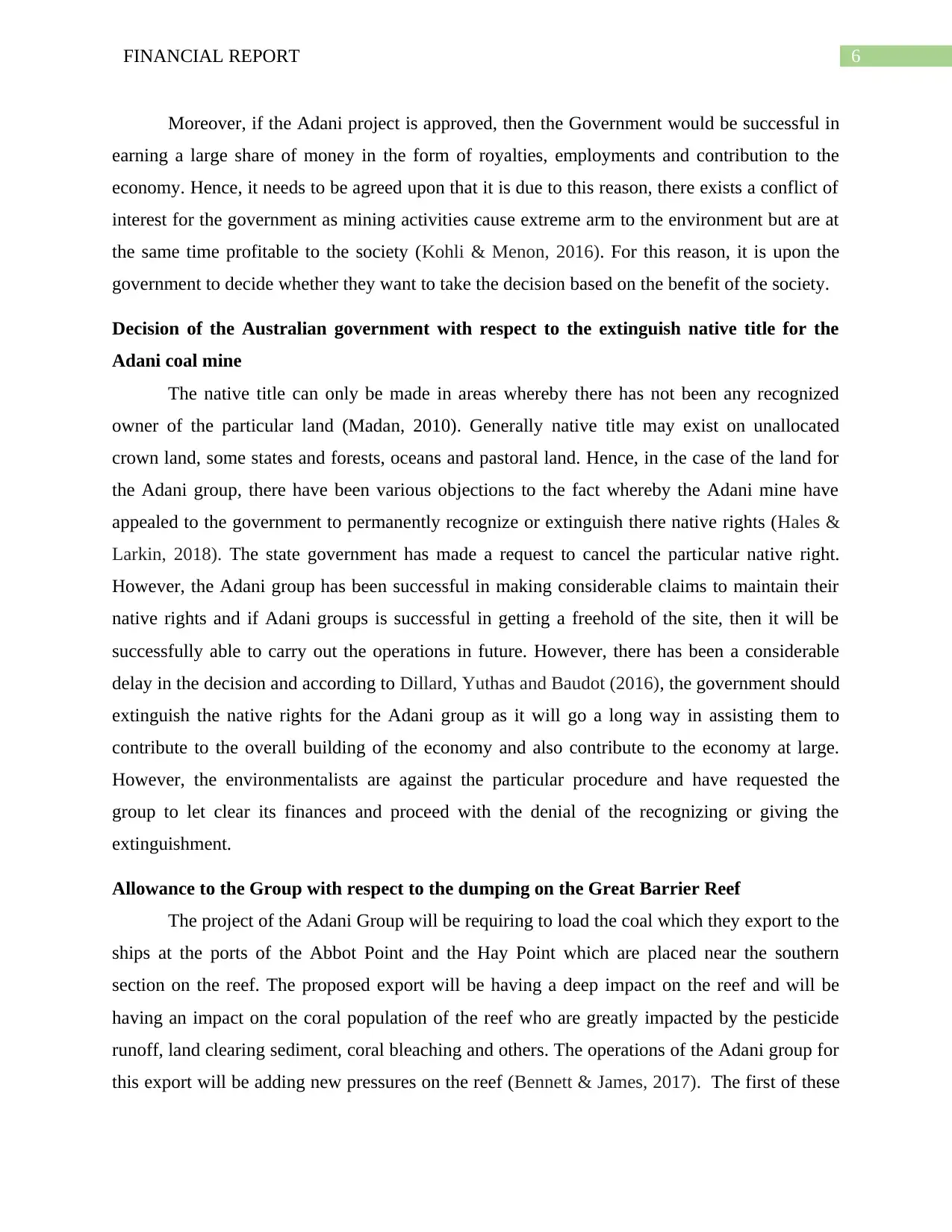
6FINANCIAL REPORT
Moreover, if the Adani project is approved, then the Government would be successful in
earning a large share of money in the form of royalties, employments and contribution to the
economy. Hence, it needs to be agreed upon that it is due to this reason, there exists a conflict of
interest for the government as mining activities cause extreme arm to the environment but are at
the same time profitable to the society (Kohli & Menon, 2016). For this reason, it is upon the
government to decide whether they want to take the decision based on the benefit of the society.
Decision of the Australian government with respect to the extinguish native title for the
Adani coal mine
The native title can only be made in areas whereby there has not been any recognized
owner of the particular land (Madan, 2010). Generally native title may exist on unallocated
crown land, some states and forests, oceans and pastoral land. Hence, in the case of the land for
the Adani group, there have been various objections to the fact whereby the Adani mine have
appealed to the government to permanently recognize or extinguish there native rights (Hales &
Larkin, 2018). The state government has made a request to cancel the particular native right.
However, the Adani group has been successful in making considerable claims to maintain their
native rights and if Adani groups is successful in getting a freehold of the site, then it will be
successfully able to carry out the operations in future. However, there has been a considerable
delay in the decision and according to Dillard, Yuthas and Baudot (2016), the government should
extinguish the native rights for the Adani group as it will go a long way in assisting them to
contribute to the overall building of the economy and also contribute to the economy at large.
However, the environmentalists are against the particular procedure and have requested the
group to let clear its finances and proceed with the denial of the recognizing or giving the
extinguishment.
Allowance to the Group with respect to the dumping on the Great Barrier Reef
The project of the Adani Group will be requiring to load the coal which they export to the
ships at the ports of the Abbot Point and the Hay Point which are placed near the southern
section on the reef. The proposed export will be having a deep impact on the reef and will be
having an impact on the coral population of the reef who are greatly impacted by the pesticide
runoff, land clearing sediment, coral bleaching and others. The operations of the Adani group for
this export will be adding new pressures on the reef (Bennett & James, 2017). The first of these
Moreover, if the Adani project is approved, then the Government would be successful in
earning a large share of money in the form of royalties, employments and contribution to the
economy. Hence, it needs to be agreed upon that it is due to this reason, there exists a conflict of
interest for the government as mining activities cause extreme arm to the environment but are at
the same time profitable to the society (Kohli & Menon, 2016). For this reason, it is upon the
government to decide whether they want to take the decision based on the benefit of the society.
Decision of the Australian government with respect to the extinguish native title for the
Adani coal mine
The native title can only be made in areas whereby there has not been any recognized
owner of the particular land (Madan, 2010). Generally native title may exist on unallocated
crown land, some states and forests, oceans and pastoral land. Hence, in the case of the land for
the Adani group, there have been various objections to the fact whereby the Adani mine have
appealed to the government to permanently recognize or extinguish there native rights (Hales &
Larkin, 2018). The state government has made a request to cancel the particular native right.
However, the Adani group has been successful in making considerable claims to maintain their
native rights and if Adani groups is successful in getting a freehold of the site, then it will be
successfully able to carry out the operations in future. However, there has been a considerable
delay in the decision and according to Dillard, Yuthas and Baudot (2016), the government should
extinguish the native rights for the Adani group as it will go a long way in assisting them to
contribute to the overall building of the economy and also contribute to the economy at large.
However, the environmentalists are against the particular procedure and have requested the
group to let clear its finances and proceed with the denial of the recognizing or giving the
extinguishment.
Allowance to the Group with respect to the dumping on the Great Barrier Reef
The project of the Adani Group will be requiring to load the coal which they export to the
ships at the ports of the Abbot Point and the Hay Point which are placed near the southern
section on the reef. The proposed export will be having a deep impact on the reef and will be
having an impact on the coral population of the reef who are greatly impacted by the pesticide
runoff, land clearing sediment, coral bleaching and others. The operations of the Adani group for
this export will be adding new pressures on the reef (Bennett & James, 2017). The first of these
Paraphrase This Document
Need a fresh take? Get an instant paraphrase of this document with our AI Paraphraser
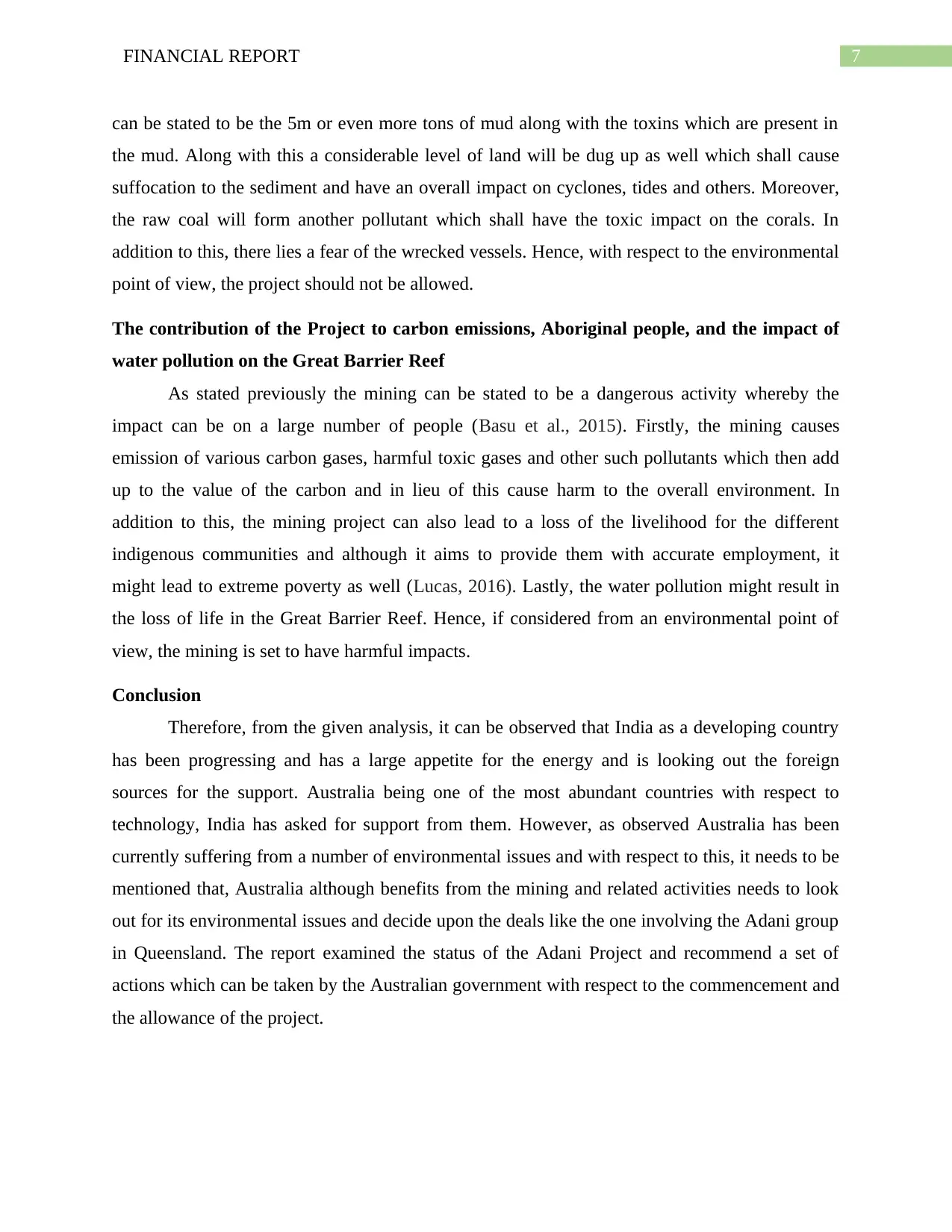
7FINANCIAL REPORT
can be stated to be the 5m or even more tons of mud along with the toxins which are present in
the mud. Along with this a considerable level of land will be dug up as well which shall cause
suffocation to the sediment and have an overall impact on cyclones, tides and others. Moreover,
the raw coal will form another pollutant which shall have the toxic impact on the corals. In
addition to this, there lies a fear of the wrecked vessels. Hence, with respect to the environmental
point of view, the project should not be allowed.
The contribution of the Project to carbon emissions, Aboriginal people, and the impact of
water pollution on the Great Barrier Reef
As stated previously the mining can be stated to be a dangerous activity whereby the
impact can be on a large number of people (Basu et al., 2015). Firstly, the mining causes
emission of various carbon gases, harmful toxic gases and other such pollutants which then add
up to the value of the carbon and in lieu of this cause harm to the overall environment. In
addition to this, the mining project can also lead to a loss of the livelihood for the different
indigenous communities and although it aims to provide them with accurate employment, it
might lead to extreme poverty as well (Lucas, 2016). Lastly, the water pollution might result in
the loss of life in the Great Barrier Reef. Hence, if considered from an environmental point of
view, the mining is set to have harmful impacts.
Conclusion
Therefore, from the given analysis, it can be observed that India as a developing country
has been progressing and has a large appetite for the energy and is looking out the foreign
sources for the support. Australia being one of the most abundant countries with respect to
technology, India has asked for support from them. However, as observed Australia has been
currently suffering from a number of environmental issues and with respect to this, it needs to be
mentioned that, Australia although benefits from the mining and related activities needs to look
out for its environmental issues and decide upon the deals like the one involving the Adani group
in Queensland. The report examined the status of the Adani Project and recommend a set of
actions which can be taken by the Australian government with respect to the commencement and
the allowance of the project.
can be stated to be the 5m or even more tons of mud along with the toxins which are present in
the mud. Along with this a considerable level of land will be dug up as well which shall cause
suffocation to the sediment and have an overall impact on cyclones, tides and others. Moreover,
the raw coal will form another pollutant which shall have the toxic impact on the corals. In
addition to this, there lies a fear of the wrecked vessels. Hence, with respect to the environmental
point of view, the project should not be allowed.
The contribution of the Project to carbon emissions, Aboriginal people, and the impact of
water pollution on the Great Barrier Reef
As stated previously the mining can be stated to be a dangerous activity whereby the
impact can be on a large number of people (Basu et al., 2015). Firstly, the mining causes
emission of various carbon gases, harmful toxic gases and other such pollutants which then add
up to the value of the carbon and in lieu of this cause harm to the overall environment. In
addition to this, the mining project can also lead to a loss of the livelihood for the different
indigenous communities and although it aims to provide them with accurate employment, it
might lead to extreme poverty as well (Lucas, 2016). Lastly, the water pollution might result in
the loss of life in the Great Barrier Reef. Hence, if considered from an environmental point of
view, the mining is set to have harmful impacts.
Conclusion
Therefore, from the given analysis, it can be observed that India as a developing country
has been progressing and has a large appetite for the energy and is looking out the foreign
sources for the support. Australia being one of the most abundant countries with respect to
technology, India has asked for support from them. However, as observed Australia has been
currently suffering from a number of environmental issues and with respect to this, it needs to be
mentioned that, Australia although benefits from the mining and related activities needs to look
out for its environmental issues and decide upon the deals like the one involving the Adani group
in Queensland. The report examined the status of the Adani Project and recommend a set of
actions which can be taken by the Australian government with respect to the commencement and
the allowance of the project.
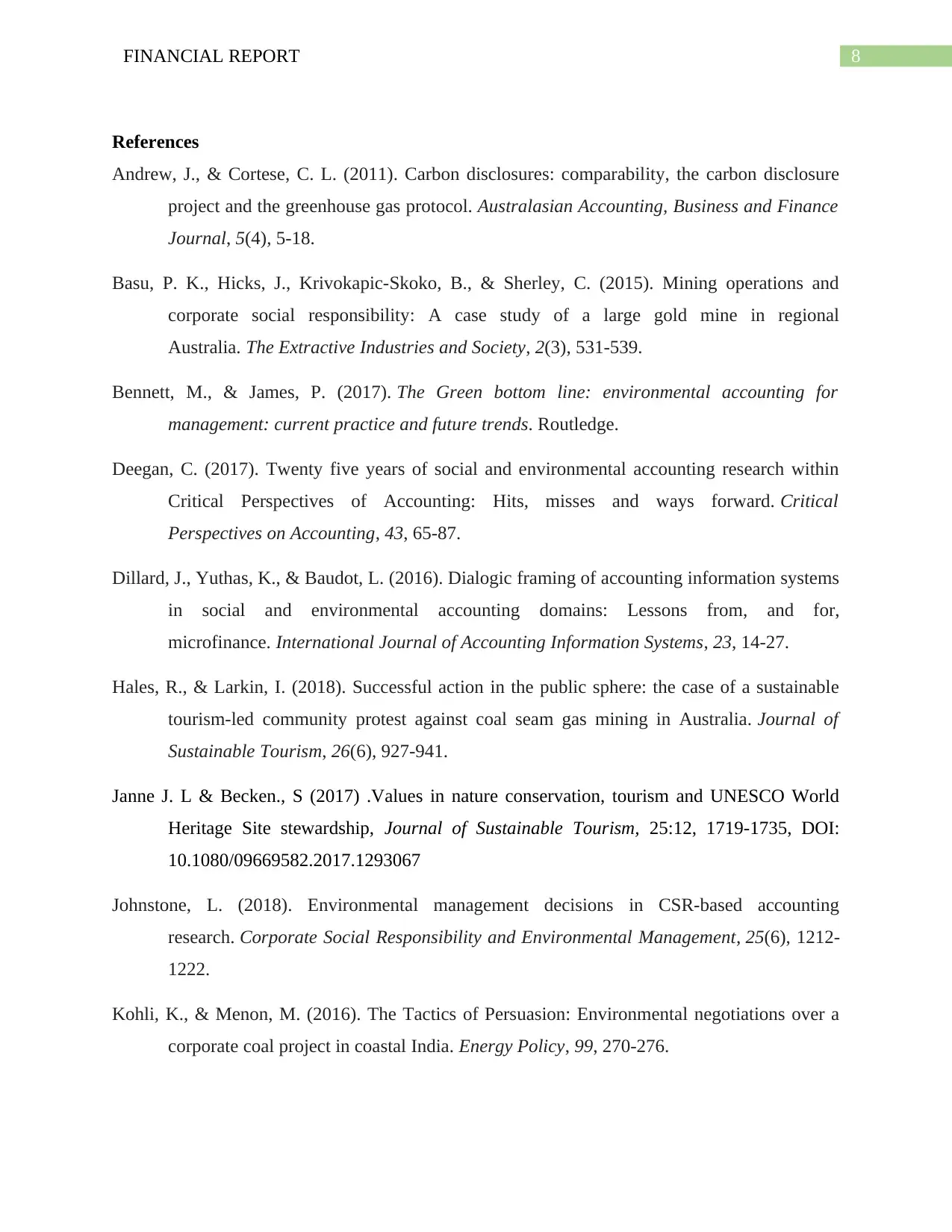
8FINANCIAL REPORT
References
Andrew, J., & Cortese, C. L. (2011). Carbon disclosures: comparability, the carbon disclosure
project and the greenhouse gas protocol. Australasian Accounting, Business and Finance
Journal, 5(4), 5-18.
Basu, P. K., Hicks, J., Krivokapic-Skoko, B., & Sherley, C. (2015). Mining operations and
corporate social responsibility: A case study of a large gold mine in regional
Australia. The Extractive Industries and Society, 2(3), 531-539.
Bennett, M., & James, P. (2017). The Green bottom line: environmental accounting for
management: current practice and future trends. Routledge.
Deegan, C. (2017). Twenty five years of social and environmental accounting research within
Critical Perspectives of Accounting: Hits, misses and ways forward. Critical
Perspectives on Accounting, 43, 65-87.
Dillard, J., Yuthas, K., & Baudot, L. (2016). Dialogic framing of accounting information systems
in social and environmental accounting domains: Lessons from, and for,
microfinance. International Journal of Accounting Information Systems, 23, 14-27.
Hales, R., & Larkin, I. (2018). Successful action in the public sphere: the case of a sustainable
tourism-led community protest against coal seam gas mining in Australia. Journal of
Sustainable Tourism, 26(6), 927-941.
Janne J. L & Becken., S (2017) .Values in nature conservation, tourism and UNESCO World
Heritage Site stewardship, Journal of Sustainable Tourism, 25:12, 1719-1735, DOI:
10.1080/09669582.2017.1293067
Johnstone, L. (2018). Environmental management decisions in CSR‐based accounting
research. Corporate Social Responsibility and Environmental Management, 25(6), 1212-
1222.
Kohli, K., & Menon, M. (2016). The Tactics of Persuasion: Environmental negotiations over a
corporate coal project in coastal India. Energy Policy, 99, 270-276.
References
Andrew, J., & Cortese, C. L. (2011). Carbon disclosures: comparability, the carbon disclosure
project and the greenhouse gas protocol. Australasian Accounting, Business and Finance
Journal, 5(4), 5-18.
Basu, P. K., Hicks, J., Krivokapic-Skoko, B., & Sherley, C. (2015). Mining operations and
corporate social responsibility: A case study of a large gold mine in regional
Australia. The Extractive Industries and Society, 2(3), 531-539.
Bennett, M., & James, P. (2017). The Green bottom line: environmental accounting for
management: current practice and future trends. Routledge.
Deegan, C. (2017). Twenty five years of social and environmental accounting research within
Critical Perspectives of Accounting: Hits, misses and ways forward. Critical
Perspectives on Accounting, 43, 65-87.
Dillard, J., Yuthas, K., & Baudot, L. (2016). Dialogic framing of accounting information systems
in social and environmental accounting domains: Lessons from, and for,
microfinance. International Journal of Accounting Information Systems, 23, 14-27.
Hales, R., & Larkin, I. (2018). Successful action in the public sphere: the case of a sustainable
tourism-led community protest against coal seam gas mining in Australia. Journal of
Sustainable Tourism, 26(6), 927-941.
Janne J. L & Becken., S (2017) .Values in nature conservation, tourism and UNESCO World
Heritage Site stewardship, Journal of Sustainable Tourism, 25:12, 1719-1735, DOI:
10.1080/09669582.2017.1293067
Johnstone, L. (2018). Environmental management decisions in CSR‐based accounting
research. Corporate Social Responsibility and Environmental Management, 25(6), 1212-
1222.
Kohli, K., & Menon, M. (2016). The Tactics of Persuasion: Environmental negotiations over a
corporate coal project in coastal India. Energy Policy, 99, 270-276.
⊘ This is a preview!⊘
Do you want full access?
Subscribe today to unlock all pages.

Trusted by 1+ million students worldwide
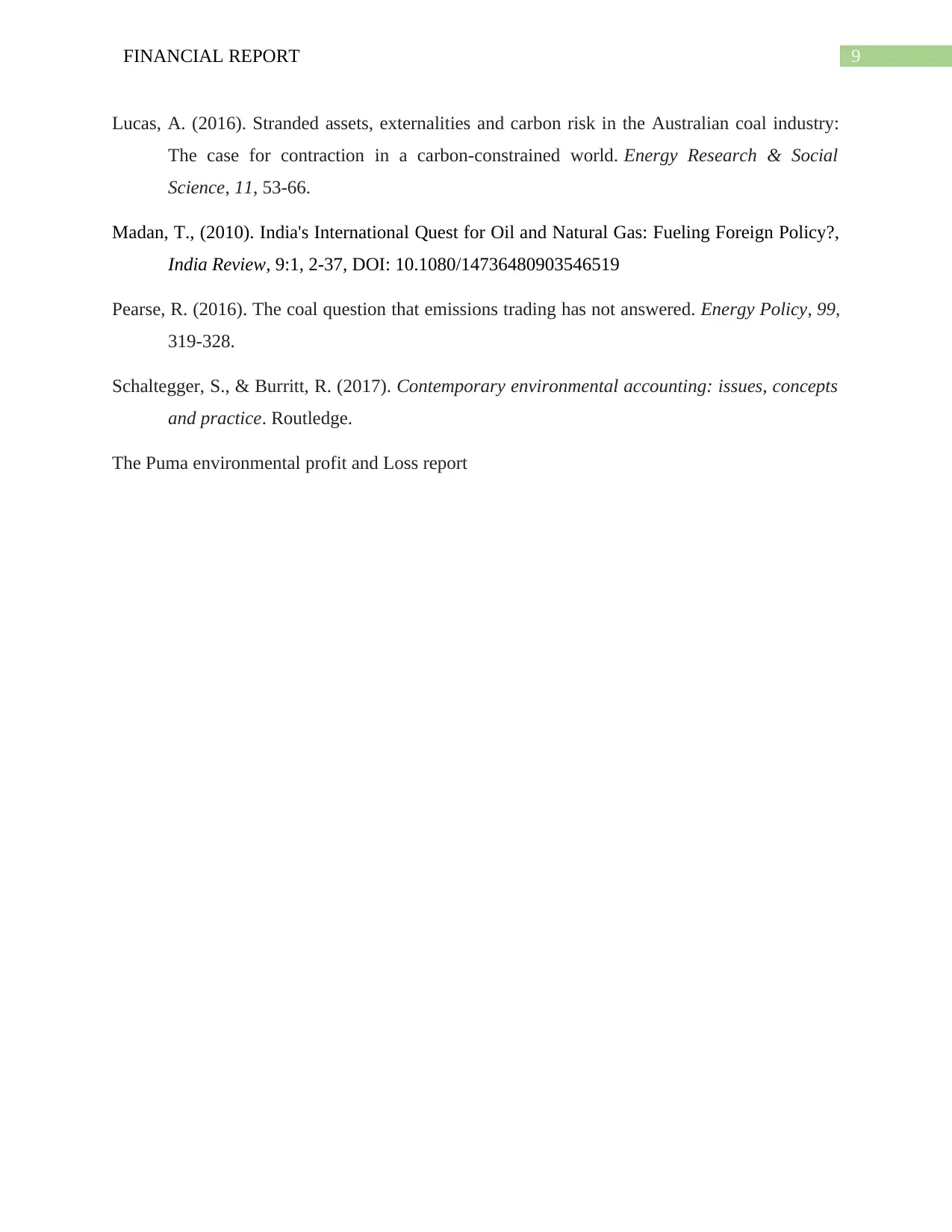
9FINANCIAL REPORT
Lucas, A. (2016). Stranded assets, externalities and carbon risk in the Australian coal industry:
The case for contraction in a carbon-constrained world. Energy Research & Social
Science, 11, 53-66.
Madan, T., (2010). India's International Quest for Oil and Natural Gas: Fueling Foreign Policy?,
India Review, 9:1, 2-37, DOI: 10.1080/14736480903546519
Pearse, R. (2016). The coal question that emissions trading has not answered. Energy Policy, 99,
319-328.
Schaltegger, S., & Burritt, R. (2017). Contemporary environmental accounting: issues, concepts
and practice. Routledge.
The Puma environmental profit and Loss report
Lucas, A. (2016). Stranded assets, externalities and carbon risk in the Australian coal industry:
The case for contraction in a carbon-constrained world. Energy Research & Social
Science, 11, 53-66.
Madan, T., (2010). India's International Quest for Oil and Natural Gas: Fueling Foreign Policy?,
India Review, 9:1, 2-37, DOI: 10.1080/14736480903546519
Pearse, R. (2016). The coal question that emissions trading has not answered. Energy Policy, 99,
319-328.
Schaltegger, S., & Burritt, R. (2017). Contemporary environmental accounting: issues, concepts
and practice. Routledge.
The Puma environmental profit and Loss report
1 out of 10
Related Documents
Your All-in-One AI-Powered Toolkit for Academic Success.
+13062052269
info@desklib.com
Available 24*7 on WhatsApp / Email
![[object Object]](/_next/static/media/star-bottom.7253800d.svg)
Unlock your academic potential
Copyright © 2020–2025 A2Z Services. All Rights Reserved. Developed and managed by ZUCOL.




